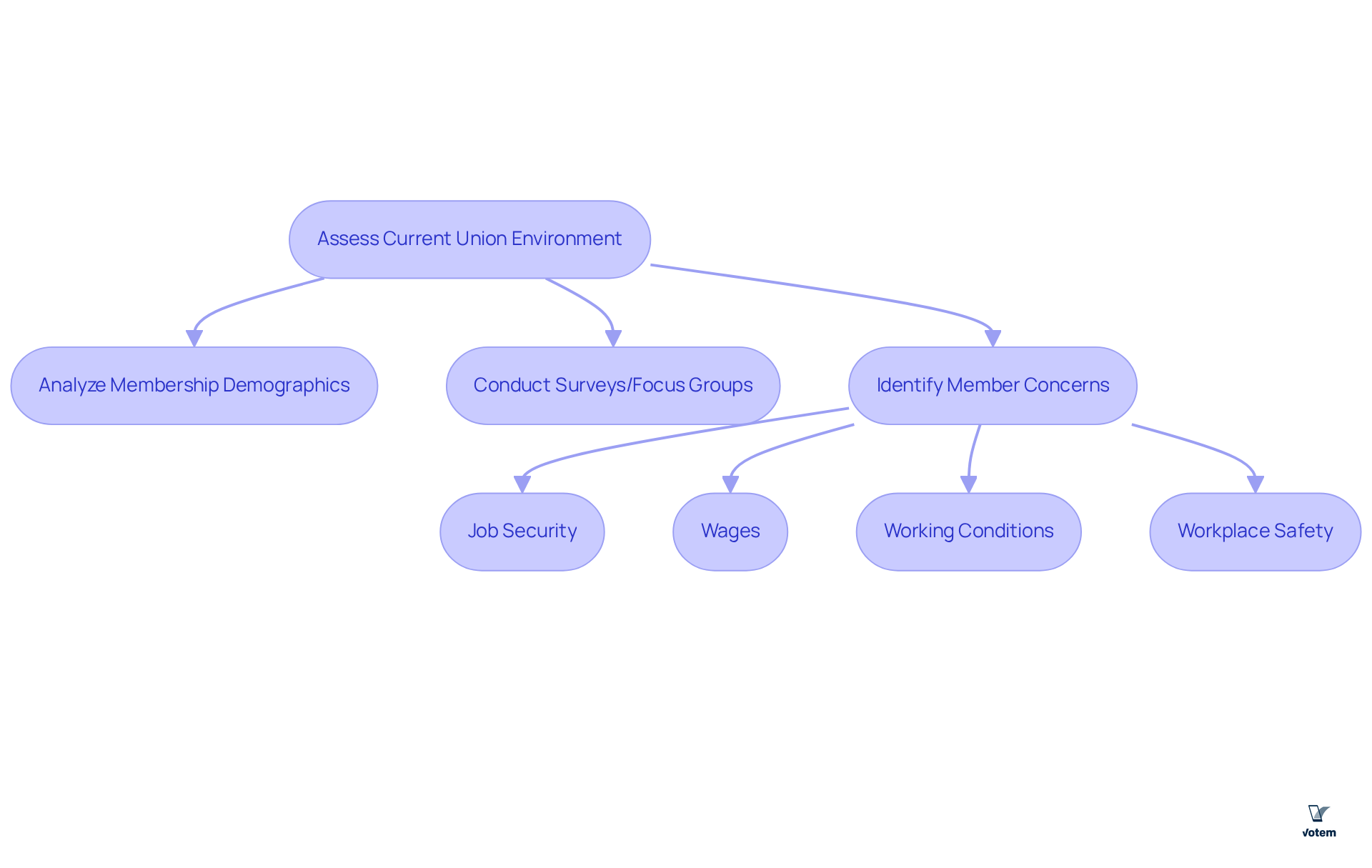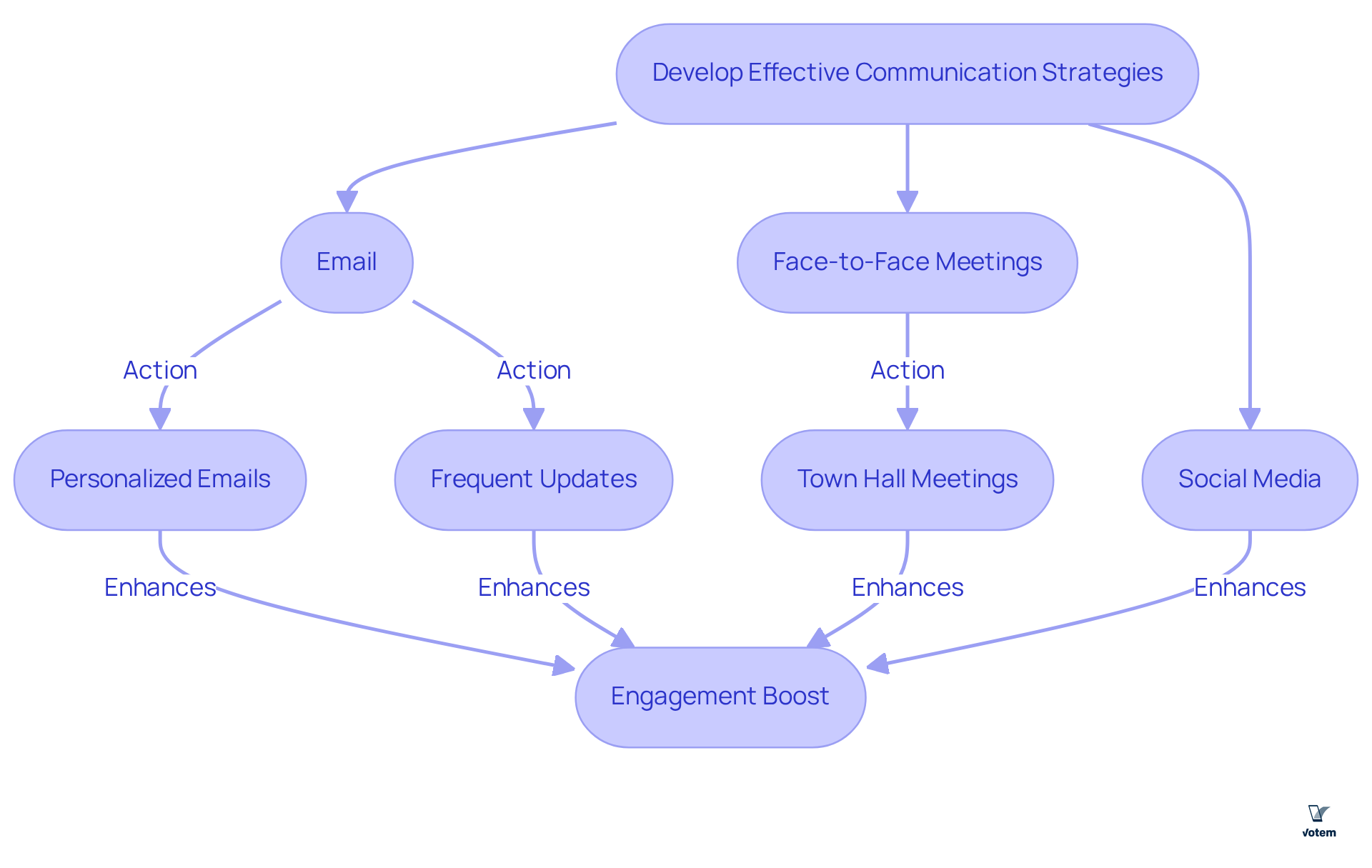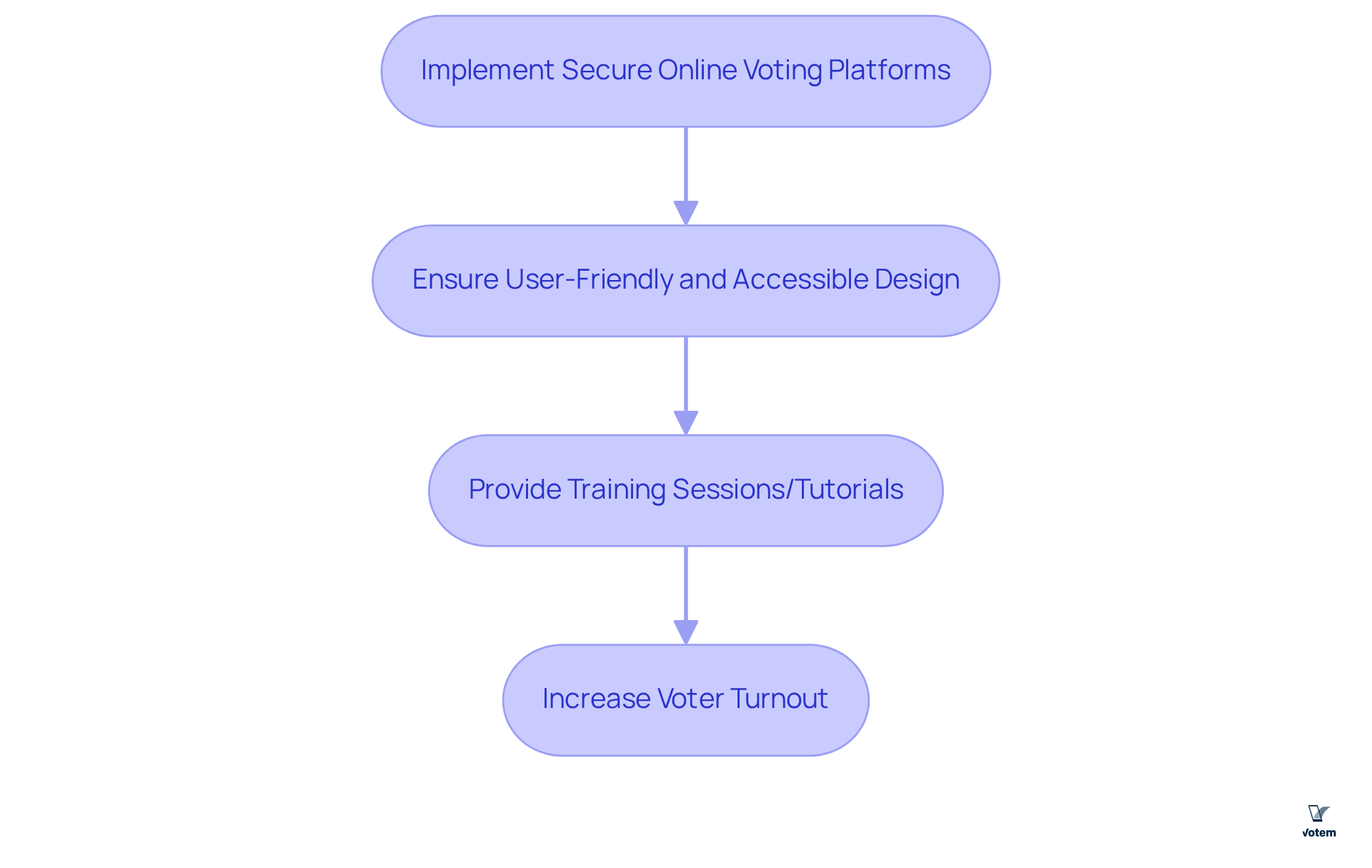Overview
The article outlines three essential strategies for union leadership in reelection campaigns:
- Understanding member needs
- Developing effective communication strategies
- Utilizing technology for secure voting
These strategies not only foster a deeper connection with members but also enhance the overall electoral process. By tailoring engagement efforts, union leaders can ensure that member voices are heard and valued.
Furthermore, the development of comprehensive communication plans is crucial. Effective communication not only informs members but also builds trust and transparency within the union. This trust is vital for encouraging active participation and engagement during the electoral process.
In addition, the implementation of user-friendly voting technology is a game-changer. By leveraging technology, unions can facilitate secure voting, making it easier for members to participate. This approach not only boosts participation rates but also reinforces trust in the electoral process. Ultimately, these strategies demonstrate that thoughtful engagement, clear communication, and innovative technology can significantly enhance member participation and confidence in union elections.
Introduction
Navigating the complexities of union leadership during reelection campaigns presents both challenges and opportunities that demand attention. Understanding the unique needs of their members and adapting strategies accordingly allows union leaders to foster engagement and drive participation effectively. However, as the landscape evolves with technological advancements and shifting member priorities, leaders must consider:
- How can they ensure they remain connected and effective?
- What strategies can be implemented to enhance member engagement?
- In what ways can technology be leveraged to improve communication?
This article explores three essential strategies that empower union leadership to not only meet the demands of their constituents but also enhance the overall electoral process.
Understand the Union Landscape and Member Needs
To effectively guide a union through its , it is essential to conduct a thorough assessment of the current union environment. This assessment should encompass an understanding of your membership’s demographics, their primary concerns, and the broader socio-political landscape. Engaging with members through surveys or focus groups will yield valuable insights into their priorities, such as job security, wages, and working conditions. This information is instrumental in shaping messaging strategies and identifying key topics that resonate with individuals, ultimately enhancing engagement and participation during the voting process.
For example, if a significant portion of your members express concerns about workplace safety, your initiative should focus on advocating for improved safety regulations and protections. By aligning your efforts with the needs and values of your constituents, you can cultivate a sense of ownership and commitment to the electoral process, which is crucial for increasing participation in the reelection.

Develop Effective Communication Strategies
To optimize participant engagement during reelection campaigns, developing a comprehensive communication plan that leverages a variety of channels, including email, social media, and face-to-face meetings, is essential. Customizing communication to address specific issues and interests of individuals ensures clarity and accessibility.
Frequent updates through newsletters or social media posts can keep individuals informed about the voting schedule, candidate platforms, and significant issues at hand. Furthermore, organizing town hall meetings or Q&A sessions provides a platform for individuals to voice their concerns and ask questions, fostering a sense of community and participation.
For instance, an association that successfully increased turnout by 30% in its most recent election achieved this through a targeted communication effort. This campaign included personalized emails, informative webinars, and engaging social media content that underscored the importance of each individual’s vote. Votem has effectively managed over 13 million votes, demonstrating its , which reinforces the effectiveness of these communication strategies. Additionally, Votem’s mobile-first user experience can enhance voter turnout by up to 3× on launch day, emphasizing the critical role of accessibility in communication strategies. Such approaches not only enhance participation but also strengthen the connection between the union and its members.

Utilize Technology for Secure and Accessible Voting
Incorporating technology into the voting process can significantly enhance both accessibility and security. Consider the implementation of secure online voting platforms that adhere to relevant regulations, such as the Labor-Management Reporting and Disclosure Act (LMRDA). These platforms facilitate remote voting, empowering individuals to cast their ballots conveniently from any location.
It is essential to ensure that the chosen technology is user-friendly and accessible to all, including individuals with disabilities. To further enhance participation, providing on utilizing the voting platform can be highly beneficial.
For instance, a workers’ organization that adopted an online voting system reported a remarkable 50% increase in voter turnout compared to previous elections conducted through traditional methods. By prioritizing security and accessibility, unions can cultivate greater trust among their members, thereby encouraging active participation in the electoral process.

Conclusion
Understanding the dynamics of union leadership during reelection campaigns is crucial for fostering engagement and ensuring a successful electoral process. By effectively assessing the union landscape and aligning strategies with member needs, leaders can create a strong foundation for participation and advocacy. This approach not only resonates with members but also reinforces their commitment to the electoral process.
Key strategies include:
- Understanding member demographics and concerns
- Developing effective communication plans
- Leveraging technology for secure and accessible voting
Engaging members through targeted outreach and utilizing diverse communication channels can significantly enhance participation. Furthermore, adopting modern voting technologies can streamline the process, making it easier for members to engage and exercise their rights.
As the landscape of union leadership evolves, it becomes imperative to prioritize member engagement and adapt to their changing needs. By implementing these strategies, union leaders can navigate the challenges of reelection while strengthening their connection with members. This ultimately fosters a more active and informed union community. Embracing these practices will pave the way for a more democratic and participatory union environment, ensuring that every voice is heard and valued in the electoral process.
Frequently Asked Questions
Why is it important to assess the current union environment during reelection efforts?
Assessing the current union environment is essential to understand the demographics, primary concerns of the membership, and the broader socio-political landscape, which helps shape effective messaging strategies and enhance member engagement.
How can unions gather insights about their members’ priorities?
Unions can gather insights through surveys or focus groups, which provide valuable information about members’ concerns such as job security, wages, and working conditions.
What should unions do if members express specific concerns, like workplace safety?
If members express concerns about workplace safety, unions should focus their initiatives on advocating for improved safety regulations and protections to address these priorities.
How does aligning union efforts with member needs impact electoral participation?
By aligning efforts with the needs and values of constituents, unions can cultivate a sense of ownership and commitment among members, which is crucial for increasing participation in the reelection process.
List of Sources
- Understand the Union Landscape and Member Needs
- freedomfoundation.com (https://freedomfoundation.com/labor/top-ten-union-quotes-from-right-to-work-hearing)
- A Back-to-School Guide to Union Membership | NEA (https://nea.org/resource-library/back-school-guide-union-membership)
- Develop Effective Communication Strategies
- Driving Member Engagement Through Effective Communication Strategies – ChamberForge (https://chamberforge.com/blog/driving-member-engagement-through-effective-communication-strategies)
- Boosting Union Engagement (https://numberanalytics.com/blog/boosting-union-engagement)
- Rethinking Union Member Communication and Engagement – UnionTrack® (https://uniontrack.com/blog/rethinking-union-member-communication-and-engagement)
- Workplace Communication Statistics (2025) (https://pumble.com/learn/communication/communication-statistics)
- Campaign Strategies for a Successful Political Campaign (https://ecanvasser.com/blog/campaign-strategies)
- Utilize Technology for Secure and Accessible Voting
- Electronic voting for labor unions: secure and smart | Eligo (https://eligovoting.com/electronic-voting-for-labor-unions-secure-smart)
- Electing Union Officers Using Remote Electronic Voting Systems (https://dol.gov/agencies/olms/compliance-assistance/tips/remote-electronic-voting-systems)
- Electronic voting review launches for trade union ballots (https://bbc.com/news/uk-37863745)

